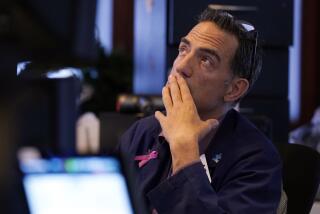Riding Out Stock Fluctuations : Pension Funds Saved by Diversity
- Share via
Thanks to their long-term orientation and diversification into other investments besides stocks, the nation’s pension funds seem to have emerged from last week’s market collapse with relatively minor wounds.
Although they own nearly a quarter of all U.S. stocks, the nation’s largest pension funds have protected themselves with substantial assets--sometimes more than half their investment--in bonds, money-market funds, real estate and other investments, pension experts say.
As a result, the bulk of the nation’s workers need not be alarmed about the safety of their basic retirement benefits, fund managers said. In fact, they have weathered the storm with little of the emotion seen among individual investors and traders.
“We’re long-term, disciplined investors; we expect to ride out fluctuations in the market,” said Thomas E. Flanigan, chief investment officer for the California State Teachers Retirement System, one of nation’s largest pension funds, which lost about 12.7% of its asset value in the past three weeks.
Stabilizing Force
“To a large extent, this (stock fall) was anticipated” among pension fund managers, said Ellen Goldstein, director of public affairs for the Assn. of Private Pension and Welfare Plans in Washington.
While many fund managers are not immediately jumping back into the market, they nonetheless see little if any long-term changes in the proportion of their assets they allocate to stocks. That proportion has grown considerably in recent years.
Such calm among such large investors could be a stabilizing force on the market, moderating wild and volatile swings, experts said. And fund managers’ confidence in the long-term attractiveness of stocks--and their plans to maintain high proportions of stocks in their total assets--could provide the buying power eventually to help fuel a new bull market.
Fund managers say they’ve stayed level-headed, despite the biggest market crash since 1929, because they don’t try to time market swings, realizing that most experts have been unsuccessful at doing so.
Instead, they tend to be buy-and-hold investors, basing their investment plans on studies showing that stocks--despite their occasional volatility--have consistently outperformed bonds and many other investments over the past 25 years or so.
“The worst thing you can do is to get whipsawed with bad market timing decisions,” said David P. Feldman, chief of the $27-billion pension fund at AT&T;, which lost about 13% of its value in the market crash.
“We’ve been through tough periods before” when stocks declined sharply, said Roland M. Machold, director of investments for the state of New Jersey and its pension funds. But in the long run, he said, stocks will come out ahead.
Pension funds also buy stocks with cash, avoiding the risk associated with buying stock with borrowed funds, otherwise known as buying on margin. Margin calls--demands from brokers that investors put up more cash or sell their stock to replenish the declining value of the stock backing the loan--have plagued individual investors and professional traders since Black Monday.
The average corporate pension plan has only about 40% to 50% of its assets in equities, with the rest in bonds, money-market funds, real estate and other investments, said Dallas Salisbury, president of the Employee Benefit Research Institute in Washington. The average public pension plan has between 20% and 40% in equities, he said.
Thus, pension funds lost on average only between 10% and 15% of their $2 trillion in assets since the late August peak in stocks, Salibury said. And their stock portfolios are still way ahead of their levels of 1982, when the bull market began, he said.
Paying Cash
Pension funds’ ability to survive the crash relatively unscathed “is going to reinforce their traditional orientation toward diversification, long-term investing and patience,” Salibury said.
While virtually no impact is expected on basic pension benefits, some workers may see smaller increases in future benefits or may not get extra checks this year, as pension surpluses--the assets above what is needed to provide benefits--have shrunk. But corporate pension funds are still overfunded by about $200 billion, compared to $350 billion at the end of last year, Salisbury said.
Still Within Range
The only workers who might see their basic benefits threatened are those at financially ailing companies in such troubled industries as steel, whose benefits were threatened even before the stock market decline.
Also, some employees’ retirement savings plans, such as the popular 401(k) company savings plans, might decline in value to the extent that employees used the plans to invest in stocks or stock mutual funds.
Many pension plan managers say the market collapse--by making stocks worth less--reduced at least temporarily the proportion of their assets invested in equities. But those levels still remain well within long-term ranges that most fund managers have set.
“If relative returns for stocks, bonds, real estate and venture capital change dramatically and permanently, then possibly we might alter the mix,” said AT&T; pension chief Feldman. “But there is no evidence of that taking place. We still expect stocks to outperform bonds over the long haul.”
The AT&T; fund went from 55% in stocks to 50% due to the crash, but that is still well within its long-term range of between 40% and 60%, Feldman said.
However, if stocks decline a lot further or if volatility persists, some funds may need to reassess their emphasis on stocks, said Lawrence E. Davanzo, general partner in charge of pension consulting at Wilshire Associates in Santa Monica.
“What we’ve seen in the last couple of days is without precedent” in terms of risk and volatility, Davanzo said. If that persists, it may be harder for funds to justify having the same proportion of their assets in stocks as they had before, he said.
Looking for Bargains
Also, the market crash could result in other changes. Pension funds may be more skeptical of using portfolio insurance, which uses stock-index futures and options to hedge against losses in declining markets. Portfolio insurance generally was ineffective in moderating losses from last Monday’s crash, many fund managers said.
In the meantime, most fund managers are studying opportunities to buy stocks when the dust settles. Some, however, are not waiting.
Such is the case at the California Public Employees Retirement System, the nation’s largest public pension plan. Assets invested in stocks went from about 47% before the Oct. 19 crash to about 36% now, said Greta E. Marshall, the fund’s investment manager. That represented a loss of about $5.5 billion, or 12% of the fund’s total assets, since the end of August.
But Marshall said the fund has been aggressively buying from a list of some 70 to 80 stocks that it considers to be “bargains.”
“It’s like going to a store and finding a dress priced 35% to 40% less than a month ago,” Marshall said. “Unless we see a serious decline in the economy, these are attractive levels to buy.”
More to Read
Inside the business of entertainment
The Wide Shot brings you news, analysis and insights on everything from streaming wars to production — and what it all means for the future.
You may occasionally receive promotional content from the Los Angeles Times.










